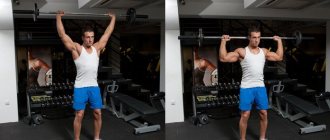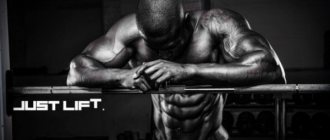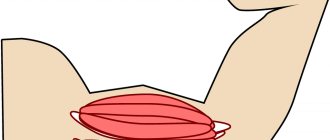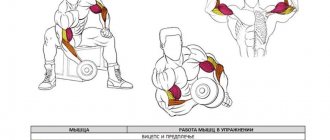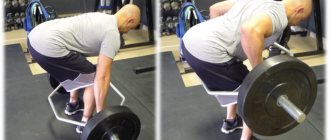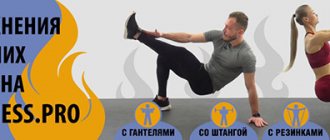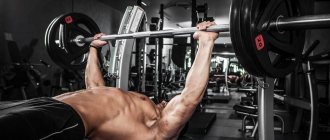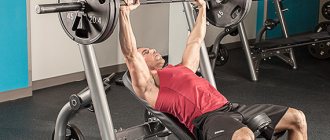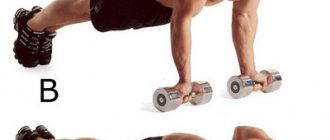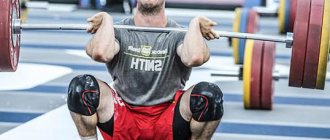Lifting the barbell to the chest is also called clean. Some old school athletes refer to this exercise as the push pull. The essence does not change from this. The movement consists of lifting the apparatus from the platform to the shoulders using the strength of the legs and inertia. It resembles a deadlift in its trajectory, but differs in that during the lift the apparatus is literally lifted onto the shoulders and the body and arms are involved in the movement. The exercise has found its use in multiple disciplines. Weightlifters use it as a special preparatory exercise. Like competitive – CrossFitters. As part of general physical training – those training for basketball, American football and strength and speed disciplines. Some trainers believe that lifts can also be done in fitness. By the way, even in the Hot Iron group lesson there are mini-barbell cleans. After all, this movement helps to quickly burn a lot of extra calories.
Execution technique
Initial position
- The bar lies on the floor, ideally on a level platform. If the ideal is not achieved in your gym, stand so that your pelvic bones are in a plane parallel to the bar; it is not necessary to align your body with the position of the wall;
- The athlete approaches the bar at a distance at which the bar would be projected onto the middle of the arch of the foot, and from this position extends his arms forward shoulder-width apart;
- It is in this position that the palms are lowered onto the bar so that a symmetrical grip is achieved. The athlete stretches his arms by lowering the pelvis slightly down and bending at the hip joint;
- The back tenses along with the arms, there is no need to perform any special tightness here, static tension of the back muscles is enough
Movement
- The barbell is removed from the platform by tension, that is, the arms are stretched, the athlete rests his feet on the platform and sharply lifts the bar off the floor;
- The movement is high-speed, unlike the deadlift;
- At the height of the knee, the legs are pushed off the platform, a light jump is performed and the projectile is detonated;
Note : detonating a projectile is a method of accelerating it, forced acceleration
- The rod, by inertia, flies over the level of the pockets;
- Next, the arms are turned on, and with the help of bending the elbows, the projectile is brought out to the shoulders;
- There are two options: either the athlete goes into a squat together with the barbell, or as soon as the projectile reaches the chest line, the athlete lowers into a light squat and stands up;
- In game sports disciplines, it is allowed to stand up without squatting. A similar technique is allowed in CrossFit. In weightlifting, either a full squat or a third of a squat is performed, but straight leg stand-ups are not allowed;
- In strongman, an incomplete lift is allowed. The athlete brings the bar to the middle of the chest or to the solar plexus, and then rolls it onto the shoulders by bending the back;
- The reverse movement is either dropping the barbell onto the platform, if this is an exercise with a heavy weight, to a repeated maximum, or lowering it. In all cases, it is safer to reset and re-take from the starting position.
Barbell clean - Vladimir Laptev
Errors
- Bouncing the weight off the floor . At the start, the athlete seems to throw the barbell on the platform, after which he begins deadlifting and lifting;
- Hand jerk . If tightening your arms before starting the exercise is a necessary part of the movement, then you don’t need to jerk the projectile with your hands and try to lift it onto your biceps after lifting it. If there is not enough inertia and speed underground, the barbell is simply thrown onto the platform;
- Round lumbar region . Some top athletes start with a rounded chest, or even with shoulders rounded forward. But the lumbar region remains tensely arched, as if inserted into the back;
- Arms bent at the elbows at the start . With this position of the arms, the athlete cannot tighten himself and is not able to lift the barbell correctly;
- Shoulders at different heights . The error occurs due to a violation of posture, which a person cannot control with a shoulder strap;
- Do not bend your knees correctly when trying to pull the barbell with your hands from the deadlift position
Push
This exercise is performed second in a weightlifting competition. To perform a push, the athlete rises after squatting and fixes the position. In this case, the body should be strictly vertical, maintaining a deflection in the lower back, the feet should be spaced wider than the shoulders, the position should be as stable as possible. The elbows are brought forward, and the pelvis is moved back slightly. The bar of the bar lies on the chest, the head is slightly abducted, the gaze is directed slightly above the horizontal.
Push exercise.
Half-squat
The athlete squats shallowly, moving the pelvis back, but maintaining a vertical body position. The movement should not be performed too quickly, as in this case the bar will come off the chest and a powerful push will not work. It is necessary to use the elastic properties of the projectile. A deep squat in this phase of the exercise will also significantly complicate the subsequent push-out, so there is no need to bend your knees too much.
Pushing
Immediately from a half-squat position, the athlete, with a sharp and powerful movement, pushes the projectile vertically upward. The phase ends with almost full extension of the legs, stepping onto the toes and raising the shoulders. The bar is given a sharp acceleration, as in the case of the “undermining” discussed earlier.
Podsed
As the bar moves upward, the athlete quickly moves underneath it, extending his arms and accepting the barbell to complete the movement. Just as in the case of the snatch, the position of the legs in the squat can be either “spread” or “scissors”.
Squat rise
Exit to vertical position. The barbell is held behind the head with outstretched arms, the body is straight, there is a deflection in the lower back, the pelvis is slightly laid back. The gaze is directed horizontally.
Fixation
The athlete completes the exercise.
Adviсe
- Good squat cleans can only be achieved if the back is tense, the arms are also tense, and the legs are actively resting and pushing into the platform. The body must be rigid and, as it were, create one structure with the barbell, so relaxed muscles at the start are a mistake;
- The bar initially moves strictly along the shin, then it is depreciated;
- The reverse movement should be absorbed by the knees;
- It is difficult to lift the barbell simply with your hands from the lifting position, so if there is not enough inertia, you should throw the barbell onto the platform;
- The lift should not start from the knee; the appropriate time is when the bar passes the thigh. The removal of the apparatus from the platform occurs smoothly, using the deadlift technique, and the bar slides along the shin;
- The deadlift can be trained on a separate day, but the speed of the clean is much greater than the speed of the deadlift;
- Raising your shoulders slightly as the bar lands on your chest helps soften the impact;
- Do not lower the barbell through your hip, that is, do not rest the barbell on your thighs when attempting to return the barbell;
- Beginners practice the exercise technique with an empty bar or a light stick; there is no point in increasing the weight until the elements are mastered;
- If the athlete is a complete beginner, he should work on shoulder mobility with a plastic stick or light bar;
- Crossfitters must first learn how to do an exercise technically correctly, and only then perform it in a high-repetition mode;
- You cannot focus on the weight in the deadlift when performing cleans. There is some relationship between these weights, but it is not so great, because the exercises differ in dynamics.
Typical beginner mistakes
- Joints and ligaments are not prepared for work. Snatching the barbell to the chest puts a lot of stress on the elbow and wrist joints when holding the barbell on the chest and on the hamstrings when the barbell is released. To avoid unpleasant consequences, warm up thoroughly. Warm up your elbows from all angles: perform triceps extensions, dumbbell curls, push-ups, or close-grip bench presses. To prevent knee injury, perform a couple of sets of seated extensions and front squats with minimal weight. Use elastic wraps on your knees and elbows to minimize the risk of injury.
- Lumbar rounding. Many beginners think that if they use an athletic belt, they can forget about supporting their back. This is wrong! If you round your back, the belt will fix only the part of the lower back that it covers, and everything that is higher will be hunched.
- The weight of the projectile is too high. Avoid heavy weights until you have perfected your clean technique.
Execution options
- Hanging rise . This option does not allow you to work on the fall phase, but the back on it is activated automatically as soon as the bar is lowered in straight outstretched arms, and therefore the rise from the hang is easier;
- Rise from pockets . It is performed with straight outstretched arms and from the level of the pockets, the goal is to practice undermining and leg movements. This allows you to gain speed, but this variation is not recommended for people with problematic spines and protrusions in the thoracic region.
Standing barbell curls
The exercise has traditional execution options, since different grips and types of bar load the muscle tissue of the arm in different ways, making it possible to work multifacetedly on the two heads of the biceps: internal and external.
Straight barbell grip
This option involves the use of a barbell with a straight bar – “Olympic”. There is also some variety here: the grip is done with the palms up at shoulder-width level, or a straight grip of the barbell is used - palms down. Variable approaches allow you to work out the biceps bundles - internal and external.
Standing ez-bar bicep curl
The use of such a barbell with a symmetrically curved bar minimizes stress on the back and wrists (which is especially important for heavy weights) and maintains the natural static and dynamic balance of the body.
The grips used with this type of bar are different: a classic lift aimed at the inner head of the muscle and a reverse lift with an overhand grip, with the elbows pulled back as much as possible - squeezing the shoulder blades will allow you to include the outer head of the muscle in the work.
- The number of options for performing the exercise increases if you remember about the grip distance - this parameter determines which of the heads will be pumped.
- The benefit of the exercise in any of the options lies in the systematic study of the indicators of the biceps muscle - volume, strength factor and endurance, however, a positive result will be possible only with competent execution technique.
Analysis of the exercise
Clean-ups should not be performed without warming up. An adequate warm-up for cleans is not only 5 minutes on the treadmill, but also a complex of any movements that rotate the shoulder outward. You need to perform a series of exercises that externally rotate the shoulder. For example, any variations of a scarecrow, or a simple rotation of the arms backwards with a rubber shock absorber or a jump rope, are adequate for this purpose.
What muscles work
From the point of view of biomechanics, lifting refers to complex coordination and functional exercises that require a coordinated effort of a volumetric array of muscle groups:
- Gluteal;
- Calf;
- Biceps femoris;
- Quadriceps;
- Trapezoidal;
- Abdominal Press;
- Erector spinae muscles;
- Latissimus dorsi muscles.
Proper execution
- Foot placement in this exercise cannot be the same for all athletes. Usually the heels are placed under the pelvic bone, but the actual width of the placement also depends on the separation of the toes. In weightlifting, there is a simple way to identify correct positioning. The athlete is placed on the box and jumps off it. The width at which he lands and the position of the toes that is obtained are the most adequate for a given athlete with his anthropometry. You should not force your toes to the sides or somehow stretch your hips in order to stand wider;
- The position of the hands, that is, the grip, is the projection of the shoulder joint. The lock grip is not recommended for this exercise when it comes to fitness. It is better to perform with a straight grip shoulder-width apart;
- The lock grip is used only in weightlifting. It requires well-developed grip strength, as well as the ability to hold weights with the thumb. This does not happen in one workout, and torn calluses are quite common in this style of training;
- The bar should be close to the body, but it won’t be possible to make a high-quality lift if you press the bar into your shins, so you need to stand so that the bar is in the projection of the arch of the foot;
- The movement should be continuous, there is no need to pause in the middle of the amplitude;
- At the final point of the take, you should raise your shoulders slightly so that the landing of the bar is as soft as possible.
Weightlifting training. Lesson #1 Barbell Clean
Errors
- The knees shift from the line of the toe, resulting in a collapse inward. Doing the lift with the knees slightly apart is recommended for those for whom this is a natural position of the legs;
- The shoulders are tilted back at the start. In this position it will not be possible to make a detonation;
- The bar does not go along the legs but along an imaginary arcuate line;
- In the undermining, a blow is made to the pockets, that is, pushing off with the hips;
- Coordination of movements is impaired, and the athlete simply cannot keep up with the barbell;
- When moving from phase to phase, a cool-down is performed and the athlete drags the apparatus with his muscles
The speed of the lift from the platform is not high; the athlete lifts with force, not technique - the main reason that the lift fails. The lack of tension at the bottom point of the movement does not allow for a high-quality break, the result is a movement in the back, and during the lift the athlete cannot open up - in this case, it is recommended to work with the pull to the knees at a very fast pace in order to master the lift in the next phase.
Jerk
This is the first exercise performed in a weightlifting or powerlifting competition. Next, the jerk technique will be considered, including the features of performing each of its phases.
Snatch exercise.
Start
In the starting position, the athlete stands in front of the apparatus so that his shoulders are strictly above the bar, and his toes are under it. The feet are shoulder-width apart, the pelvis is laid back, there is a natural arch in the lower back, and the gaze is directed forward. Slight differences in starting position are allowed depending on the height and body proportions of the athlete.
The barbell is grasped with a lock grip. The legs, body, arms and apparatus must form a single rigid frame.
Traction
The bar lifts off the floor due to the powerful force of the legs and back and rises above the level of the knees. The bar moves along the legs not vertically, but slightly towards itself. The arms and back are absolutely straight in this phase of the movement. Lifting the bar from the platform occurs calmly, then the speed of the projectile increases sharply.
Detonation
This is the moment of accelerating the projectile due to the full extension of the legs and straightening of the body, reaching out onto the toes. The effort must be sharp and powerful. Arms are still straight. During the lift, the athlete tilts his torso back and raises his shoulders.
Podsed (care)
Thanks to the acceleration applied at the detonation stage, the bar, as they say, flies up. In this phase, the athlete must quickly get under it. When the bar has lost acceleration and is already moving downwards, it is much more difficult to accept it.
During this phase of the movement, the back remains arched and the pelvis is laid back. Hands actively interact with the projectile. The athlete takes the barbell with outstretched arms (when performing a snatch) or on the chest (if a push is planned next).
The athlete’s legs can be in different positions:
- Low squat (legged), hips pressed to the stomach.
- Scissors, one leg in front, one leg behind, as in a deep lunge.
Correct and quick squatting creates an optimal “base” for subsequent lifting.
Squat rise
Immediately from the squat, due to the powerful force of the leg muscles, the athlete rises to a vertical position. The pelvis moves along a trajectory from bottom to top and slightly back, the back remains arched.
Fixation
The athlete takes the final position, clearly fixing the apparatus on outstretched arms (in the case of a jerk) or on the chest (if a push is then performed).
Performing an exercise on a Scott bench
To perform the exercise in the gym, you don’t have to limit yourself to the classic version of the barbell press. To increase the productivity of your workout, you can work with the apparatus in the lower block or on the “prayer bench” (the so-called Scott bench).
Technique for performing this variation of exercise for biceps:
- Take a sitting position on a bench in the simulator, placing your hands on a special stand. In this case, the tilt of the body should be such that it is convenient for you to take the projectile and, after the approach is completed, return it to the position.
- With a wide grip, take the bar and, using only the muscles of your arm, lift the projectile and bring it to your chin, without lowering your head towards the bar (see image).
- Holding the projectile at the top point for a couple of seconds, return to the starting position without completely relaxing your arms. Repeat the exercise enough times to develop your biceps.
When choosing an option for performing a barbell press to work out the biceps, you must also take into account the fact that the most difficult way to practice the exercise is to stand near a wall or vertical support. Working with sports equipment in this position is more difficult.
As for the choice of a bar for pumping up biceps, it all depends on the preference of the athlete himself, because performing barbell lifts with different bars (EZ or straight) differs only in the convenience of the location of the wrists while working out the bench press. The curved bar allows you to hold your wrists at a slight angle during work, which is more comfortable for some athletes than the high angle that is created when holding a projectile with a straight bar.
A training program that includes such effective exercises as barbell (or dumbbell) biceps curls allows you to pump up your arms quickly, and most importantly, efficiently, obtaining a very impressive result.
Arching into a bridge
Lifting your hips off the bench while doing the bench press will turn your body into a bridge. To some extent, this may make the exercise easier, but don't do it. In this way, you expose your spine to enormous stress, which is very fraught with lower back injuries. Keep your butt very tight on the bench, and bend only in the thoracic spine and upper back, not in the lower back.
Benefits and usefulness
Barbell curls are the leading exercise in terms of benefits for arm muscles for several reasons:
- Firstly, it has a complex effect on various parameters of the muscles of the biceps muscle of the arm, allowing it to grow, become stronger and stronger.
- Secondly, it allows you to pump up your biceps efficiently due to the optimal working range.
- Thirdly, it ensures comprehensive development of the biceps muscles if you perform the exercise in different variations (using a direct or reverse grip, wide or narrow grip and different types of bar).
In addition, if you do an exercise using a barbell with an EZ bar, athletes have the opportunity to take heavy weights without the risk of a large load on the back and lower back, since such a bar provides a position as close as possible to the natural balancing of the body. Also, using such a bar during training allows you to reduce the load placed on your wrists while working out your biceps with heavy weights.
